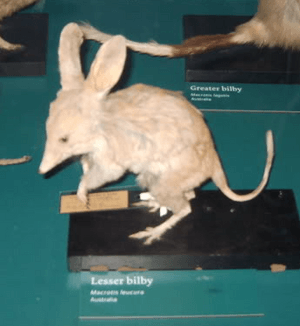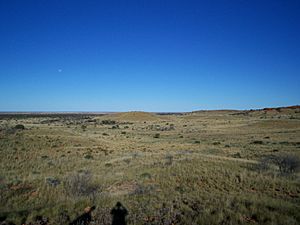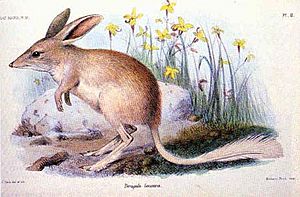Lesser bilby facts for kids
Quick facts for kids Lesser bilby |
|
|---|---|
 |
|
| A stuffed lesser bilby specimen at Tring Museum | |
| Conservation status | |
| Scientific classification | |
 |
|
| Historic lesser bilby range in orange |
The lesser bilby (Macrotis leucura) was a small animal that looked a bit like a rabbit. It was a type of marsupial, which means it carried its babies in a pouch, like a kangaroo. People also called it the yallara or the white-tailed rabbit-eared bandicoot.
This unique animal lived in the deserts of Central Australia. It was about the size of a young rabbit. Sadly, the lesser bilby is now believed to be extinct, meaning it no longer exists. The last sightings were in the 1950s or 1960s.
Contents
Discovering the Lesser Bilby
The lesser bilby was first described by a scientist named Oldfield Thomas in 1887. He named it Peregale leucura. This description came from a single animal specimen sent to the British Museum. The exact place where this first specimen was found is not known. However, scientists thought it might have come from the Northern Territory or near Adelaide.
Oldfield Thomas noticed that this new animal was similar to another bilby, the Macrotis lagotis. But he also saw enough differences to say it was a completely new species. Over the years, other scientists gave it different names, but these are now known to be the same species. One other name for this animal was the white-tailed bilby.
What Did the Lesser Bilby Look Like?
The lesser bilby was a medium-sized marsupial. It weighed between 300 and 435 grams, which is about the same as a can of soup. Its body, from head to tail, was about 20 to 27 centimeters long. Its tail added another 12 to 17 centimeters. This means its tail was about 70% of its body length!
Its fur was soft and silky. It could be pale yellowish-brown or grey-brown. Its belly, limbs, and tail were white or yellowish-white. The lesser bilby had long, movable ears, just like a rabbit. It also had a long, narrow snout. Compared to its larger cousin, the greater bilby, the lesser bilby was smaller and had shorter ears, about 6.3 centimeters long. The underside of its tail had a grey patch near the body, but the rest of its long, bushy tail was white.
Where the Lesser Bilby Lived
Scientists do not know much about where the lesser bilby used to live. This is because it was only found and studied a few times in modern history. The first specimen came from an unknown area.
In more recent times, the lesser bilby was found only in the Gibson Desert and Great Sandy Desert. These are dry, sandy areas in central Australia. It also lived in parts of northeast South Australia and southeast Northern Territory.
The lesser bilby liked to live in sandy and loamy deserts. It preferred areas with sand dunes and spinifex grasslands. Spinifex is a tough, grassy plant that grows in mounds. It also lived in areas with mulga trees or canegrass.
Lesser Bilby's Life and Habits
The lesser bilby was a nocturnal animal. This means it was active at night, just like its living relatives. During the day, it would rest in its burrow.
It was an omnivore, meaning it ate both plants and animals. Its diet included ants, termites, roots, and seeds. It was also known to hunt and eat small rodents that had been brought to Australia by people.
The lesser bilby dug burrows in the sand dunes. These burrows could be 2 to 3 meters deep. During the day, it would close the entrance to its burrow with loose sand. This helped keep it safe and cool. It is thought that lesser bilbies might have had babies at any time of the year. It was also common for them to give birth to twins.
Unlike the greater bilby, the lesser bilby was known to be quite aggressive. A scientist named Hedley Herbert Finlayson wrote that these animals were "fierce and intractable." He said they would bite and make harsh hissing sounds if someone tried to handle them.
Local Indigenous Australians had a name for this species, Urpila. They knew that the lesser bilby had a special habit. In cooler weather, it would stay close to the entrance of its burrow. Hunters would use this habit to catch them. They would collapse the tunnel behind the bilby to force it towards the sandy opening.
Why the Lesser Bilby Disappeared

After it was discovered in 1887, the lesser bilby was rarely seen. It remained a mystery to scientists for many years. In 1931, Hedley Finlayson found many lesser bilbies near Cooncherie Station. He collected 12 live ones. Even though Finlayson said the animal was common in that area, these were the last live lesser bilbies ever collected.
The very last sign of a lesser bilby was a skull found in 1967. It was found below a wedge-tailed eagle's nest in the Simpson Desert. Scientists believed the skull was less than 15 years old. Some stories from Indigenous Australians suggest the species might have survived into the 1960s.
Many things are thought to have caused the lesser bilby to disappear. These include:
- New predators like the domestic cat and fox.
- Being hunted for food by Indigenous Australians.
- Competition with rabbits for food.
- Changes in how fires were managed in the area.
- Damage to their natural home.
However, some experts believe that the main reason was the introduction of cats and foxes. They noted that the bilby's habitat was still in good condition, with little damage from farm animals or rabbits. This suggests that the new predators were the biggest problem for the lesser bilby.
See also
 In Spanish: Bilby menor para niños
In Spanish: Bilby menor para niños



